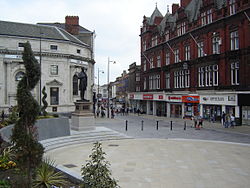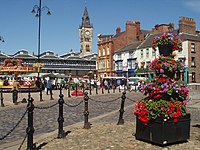Darlington
| Darlington | |
| County Durham | |
|---|---|
 Darlington town centre | |
| Location | |
| Grid reference: | NZ289147 |
| Location: | 54°31’37"N, 1°33’9"W |
| Data | |
| Population: | 97,838 (2001) |
| Post town: | Darlington |
| Postcode: | DL1 - DL3 |
| Dialling code: | 01325 |
| Local Government | |
| Council: | Darlington |
| Parliamentary constituency: |
Darlington |
Darlington is a town in County Durham. It stands in the south of the county in the Tees Valley, and is often slated as 'the gateway to the Tees Valley'. Notwithstanding the industrial nature of the lands along the lower Tees, Darlington has comparatively little heavy industry itself.
The town stands close to the Pennines, the Yorkshire Dales and Cleveland Hills; the North York Moors are also within easy reach of the town. Both the River Tees and River Skerne pass through the town, the River Skerne later joining the River Tees which then flows into the North Sea.
One of the defining moments of the Industrial Revolution gave fame to Darlington when Stevenson began the first steam-driven passenger railway service on the Stockton to Darlingon Railway. The association with the railways and rail engineering continues. Darlington railway station (Bank Top) is on the East Coast Main Line. There are also local services from the historic North Road railway station and the associated Darlington Railway Centre and Museum.
The town

Darlington town centre has built a strong focus on independent shopping, giving a breathing space from the usually high street national stores and introducing a varied and popular shopping experience. Grange Road has a number of expensive and attractive designer stores, Duke Street houses art galleries and restaurants and nestled between the two is Skinnergate, which holds the greatest variety of interesting and original stores.
A mixed town, Darlington ejoys affluent suburbs, in particular those to the south west and west of the town centre with large homes in leafy streets, and the golf course and a rugby club in Blackwell, while to the north of the town centre are the practical, working suburbs.
History

Middle Ages
Darlington started life in the Anglo-Saxon period as a settlement on the River Skerne. It has an attractive historic market area in the town centre. St Cuthbert's Church is one of the most important and impressive Early English churches in the north of England.
The railways
Darlington is known for its associations with the birth of railways. This is celebrated in the town at Darlington Railway Centre and Museum. The world's first locomotive passenger rail journey was between Shildon and Stockton-on-Tees via Darlington, on the Stockton and Darlington Railway in 1825.
The town later became an important centre for railway manufacturing, with three significant works. The largest of these was the main line locomotive works, known as North Road Shops, opened in 1863 and closed in 1966. Another was Robert Stephenson & Co. (colloquially: "Stivvies"), who moved to Darlington from Newcastle upon Tyne in 1902, became Robert Stephensons & Hawthorns in 1937, were absorbed by English Electric around 1960, and closed by 1964. The third was Faverdale Wagon Works, established in 1923 and closed in 1962, which in the 1950s was a UK pioneer in the application of mass-production techniques to the manufacture of railway goods wagons.
To commemorate the town's contribution to the railways, David Mach's 1997 work "Train" is located alongside the A66, close to the original Stockton-Darlington railway. It is a life-size brick sculpture of a steaming locomotive emerging from a tunnel, made from 185,000 "Accrington Nori" bricks. The work had a budget of £760,000.
Recent history
The town centre has undergone a full refurbishment entitled The Pedestrian Heart, which has seen the majority of the town centre pedestrianised.[1] Initially, the project received criticism surrounding changes to public transport, and removal of Victorian features along High Row.[2][3] There is now growing evidence, however, that the now-completed changes are meeting with local approval.[4]
In 2007 planning permission was granted for a new shopping centre to replace the dated and unsuccessful Queen Street shopping centre. Debenhams is to be the anchor store for the retail and leisure development. Planned to open in 2010, the project has sinced stalled, with any works yet to take place.
In August 2008 the King's Hotel in the town centre was devastated by fire, severely damaging the roof and 100 bedrooms. Several shops were damaged and had to close for weeks afterwards, though thankfully no one was killed in the blaze.
Culture
The Civic Theatre is a popular arts venue in the town, hosting a mix of musicals, dramas, plays and pantomimes. The smaller but well-used Arts Centre, founded in 1982, features smaller events, film screenings and more experimental material.
The Rhythm'n'Brews festival is a music and real ale festival normally held in early autumn, with many rock, blues and jazz acts playing at various venues around Darlington, as well as a Campaign for Real Ale (CAMRA) run bar at the Arts Centre.
The Forum Music Centre, opened in 2004, hosts regular live music events, from Ska and Punk to Indie and Classic Rock. Also runs a popular comedy club. As well as live music, the facility houses a state of the art recording studio and several rehearsal rooms. The Carmel Rhythm Club is another place for music.
Darlington Dog Show has been a championship event since 1969. It was normally held in September on the showground in South Park, although in more recent years it has moved to Ripon.
Sport
- Cricket is played by Darlington Cricket Club and Darlington Railway Athletic Cricket Club.
- Football teams in the town are Darlington, a team in the Football Conference, and Darlington Railway Athletic, a team in the Northern League.
- Rugby teams are Darlington Mowden Park RFC who play in National League Three and Darlington RFC.
- Running: The Darlington 10K road run is held every August, and attracts several thousand competitors.
- The Dolphin Centre: this sports centre provides a wide range of sporting facilities. It was opened by Roger Bannister in 1982, and received a £5 m refurbishment in 2006 and was later given a new official opening by Redcar athlete Tanni Grey-Thompson.
References and notes
- ↑ "Main Features of the Pedestrian Heart Scheme". Darlington Borough Council. http://www.darlington.gov.uk/Living/Planning+and+Building+Control/Planning+Services/Projects+and+Schemes/PedHeart/PedHeartFeatures.htm.
- ↑ "Town revamp 'may disrupt traders'". BBC News. 16 September 2005. http://news.bbc.co.uk/1/hi/england/4251676.stm. Retrieved 18 January 2008.
- ↑ "Trader hits out at the heart of the scheme". The Northern Echo. 24 April 2007. http://www.thenorthernecho.co.uk/search/display.var.1349982.0.trader_hits_out_at_the_heart_of_the_scheme.php. Retrieved 18 January 2008.
- ↑ "Hearty thanks - Town centre scheme is praised". Herald & Post. http://www.gazettelive.co.uk/news/local-teesside-news/darlington-news/2007/10/18/town-centre-scheme-is-praised-84229-19970199/.
Outside links
- Darlington Borough Council
- Statistics about Darlington from the Office for National Statistics: Census 2001
- Darlington Tourist Information
- Darlington Railway Centre & Museum
- Historic Postcards of Darlington